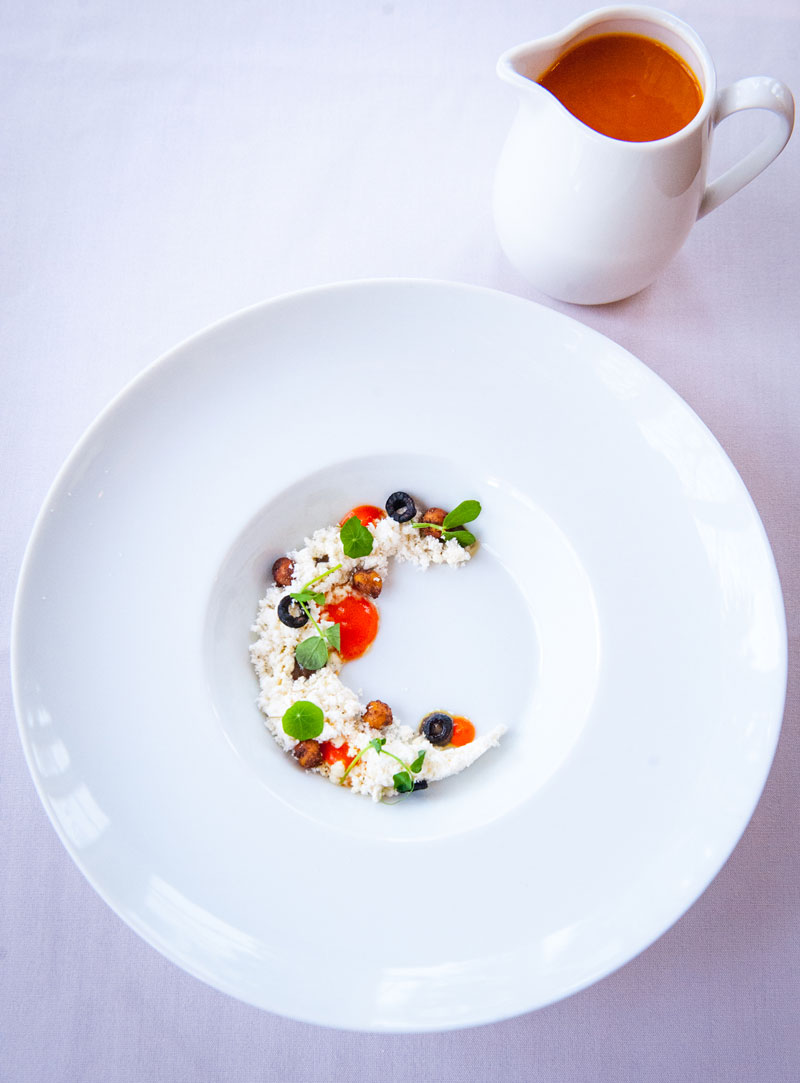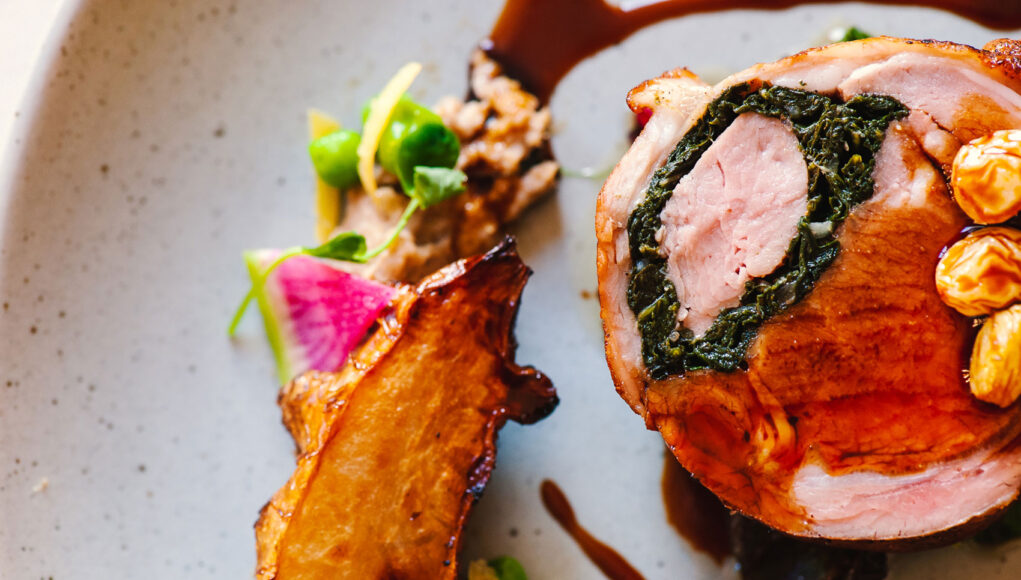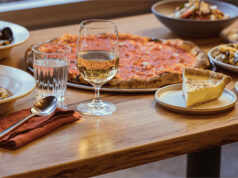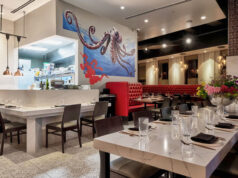The Canadian source of Rouge Restaurant’s effervescent blush is found just behind the historic red-painted 19th-century Cross House, in the massive one-acre garden where many of the best ingredients from their refined farm-to-fork menu are grown. Chef de Cuisine Dean Fast talks me through its late summer season’s harvest.

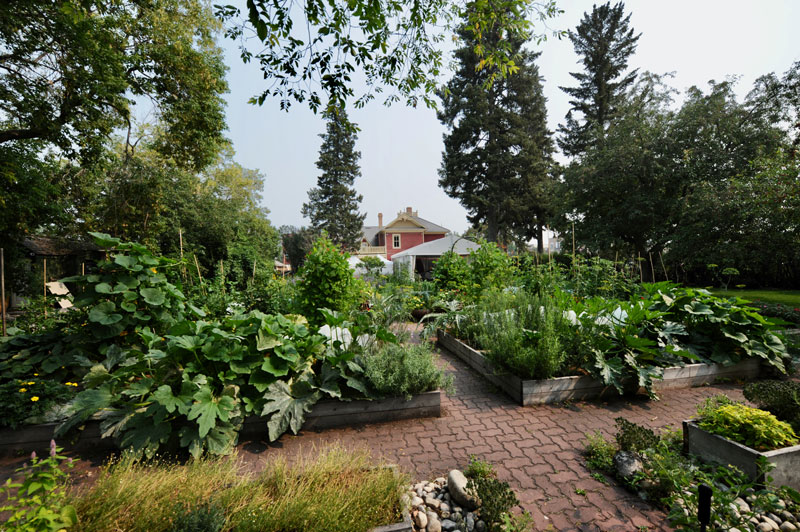 “Zucchini is in full blossom. All of the flowers are opening up and we’ve got about seven large plants that I look for a great yield. Ten pounds of garlic scapes have been pulled,” he says, “while radishes and carrots have been harvested and replanted, and the garden peas grow out of control; a beautiful thing. Finishing herbs: parsley, marjoram; varieties of lettuce–flat leaf, red, romaine,” Dean Fast adds. He remembers the aesthetics: the orchids and bachelor buttons. “A lot of different, nice finishers go a long way on the plate.” His list goes on and on.
“Zucchini is in full blossom. All of the flowers are opening up and we’ve got about seven large plants that I look for a great yield. Ten pounds of garlic scapes have been pulled,” he says, “while radishes and carrots have been harvested and replanted, and the garden peas grow out of control; a beautiful thing. Finishing herbs: parsley, marjoram; varieties of lettuce–flat leaf, red, romaine,” Dean Fast adds. He remembers the aesthetics: the orchids and bachelor buttons. “A lot of different, nice finishers go a long way on the plate.” His list goes on and on.
“I’m missing a few for sure. We’ll be picking food and garnishes right out of the garden the afternoon before they get served on the salads, and vegetables for the entrees that night.”
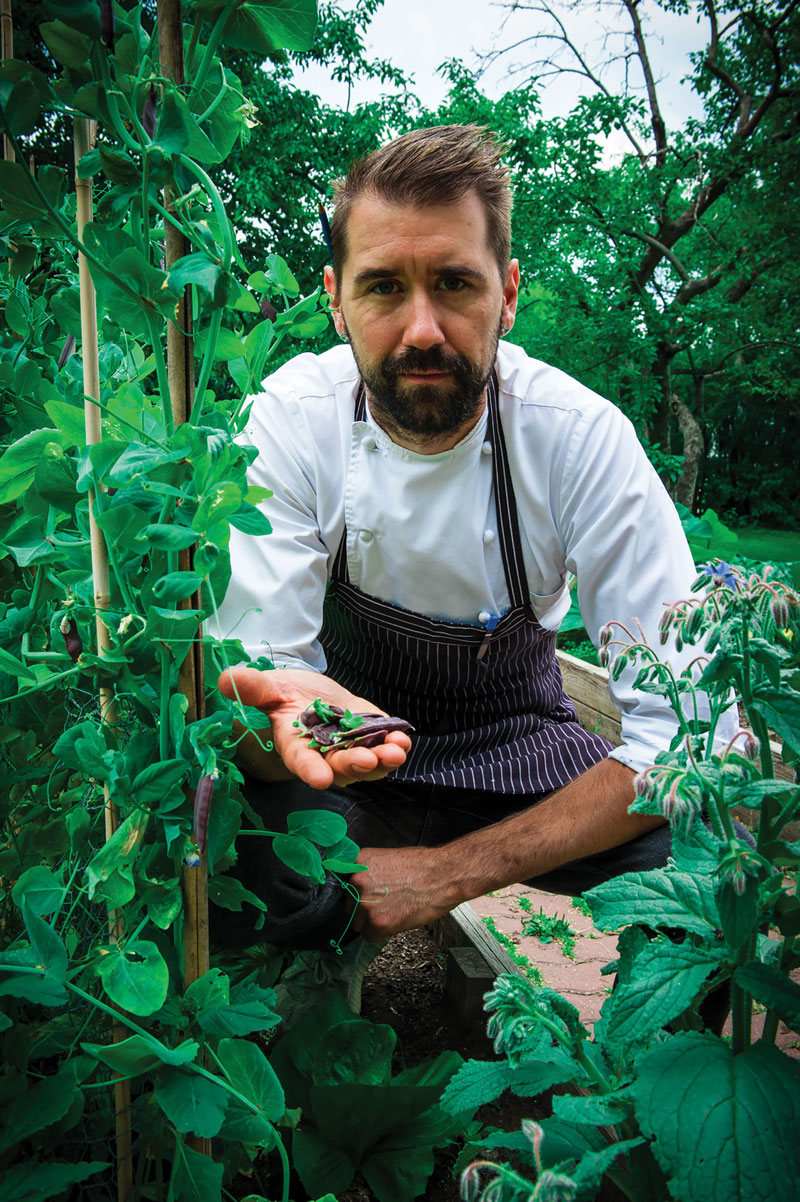 For the fall season’s changing menus, culinary inspiration can come from a lot of places. For Rouge Restaurant’s Chef de Cuisine Dean Fast, that inspiration comes from the garden. One of Calgary’s most celebrated restaurants since its opening in 2003, it boasts a host of accolades – Top 10 Restaurant in Calgary, the world’s top 100 restaurants, and Alberta’s best fine-dining restaurant. Chef Dean discusses how Alberta’s short seasons influence the seasonality of his menu.
For the fall season’s changing menus, culinary inspiration can come from a lot of places. For Rouge Restaurant’s Chef de Cuisine Dean Fast, that inspiration comes from the garden. One of Calgary’s most celebrated restaurants since its opening in 2003, it boasts a host of accolades – Top 10 Restaurant in Calgary, the world’s top 100 restaurants, and Alberta’s best fine-dining restaurant. Chef Dean discusses how Alberta’s short seasons influence the seasonality of his menu.
“Seasons are tough here in Calgary. We have really short growth periods. Even with the amount of space that we have in our garden, we’re still limited to what we can provide on the plate, based on volume and how much we can plant and utilize. What I like to do is structure our menus, which revolve around the wild harvest, so it has a bit of a foundation.”
“Every dish can be changed based on what’s coming out of the ground today or tomorrow or in this season,” Dean continues. “For example, I have this rabbit ravioli made with spinach, fava beans, and a cream sauce underneath–that’s changed into Swiss chard when spinach isn’t available and fava beans can become peas. There’s a foundation, a cement block to the dish; those side ingredients that help tell the story, change daily and seasonally with what’s available at that peak moment. So we optimize freshness and availability and are able to highlight different areas of the garden.”
I ask Dean to take me down his road to the kitchen.
“I grew up just outside Winnipeg in Portage la
Prairie, a small town,” he answers. “It wasn’t hard for me to make a decision to leave, and I kind of came out here just looking for something different. I was drawn by the mountains, of course, like most people are.”
Dean’s culinary journey begins at 14, working the kitchen at a Pizza Hut and evolves to shuttling between kitchens in Jasper so he can snowboard, to a chef’s apprenticeship in a Manitoba hotel, where he falls in love with the work, the effort, the response one gets from hospitality, and pleasing guests.
“It just clicked,” Dean says. “It’s just not a job to me. It’s a lifestyle. I found that out really young and early in my career. And I think that’s really helped me to develop, grow and understand what it takes to be successful.”
Dean started with Rouge in September 2020, and marking his two-year anniversary he speaks of his tenure. “The transition was very easy for me because this was all very familiar,” he says referencing his decade-plus experience at Q Haute Cuisine – a like-minded restaurant in the city with similar service style.
“The timing was right. And the fit seemed
perfect. It’s exciting to join a team like this with all the accolades that you mentioned–the garden, the opportunity for growth, the chance to develop my style.”
And Dean’s thoughts return to the garden. I ask how he balances his chef/gardener hats.
“It can certainly be tough. We have a small team and I’m a very hands-on chef. I’m probably the first one in and the last one out five days out of the six that I work. So, trying to make time to get out and really care for the garden is a struggle, but it’s one that’s really worth the work.”
And what goes into its planning?
“Paul Rogalski, one of the owners here, we sit down and strategize: What do we wanna plant this year? Where is it gonna go in the garden for best opportunity? How are we gonna be able to recycle the space properly? There’s a lot of thought and strategy that goes in before the hard work and the muscle of, you know, weeding, planting, and reseeding. And I try to utilize the guys in the kitchen as well to make sure that everybody spends a little bit of time in the garden.”
Dean continues, “Everybody should put their hands in that soil and understand what they’re taking out the ground to put on the plates. So, getting out there every day, whether it’s just showing up early in the morning to make sure it gets water before the hot sun hits; staying a little late to get water just before the evening, or watching the weather, making sure that that balance is on point.
The hard work pays off in the end when we’ve got guests sitting on the patio at eight o’clock while the sun’s going down and they’re looking at the sprinkler, going back and forth over top of everything they’ve just eaten, and realizing where their food came from. That’s a really important and special moment in the day.“
Refined farm-to-fork and a prestigious, acclaimed venue. “And what do you bring to this?” I ask.
Dean pauses and thinks. “If I have a style,” he begins. “I’m still pretty new at this; still working on myself in developing things, but my background’s very heavy on molecular gastronomy. I like to blend the humble part of farm-to-table and wild harvest with new techniques based on classic recipes and things, but with a slight twist. I believe heavily in presentation and the artistic side of plating food. We first eat with our eyes, always. That begins the story–what you see first and what you taste after should match, and leave you in wonder and
amazement. Humble ingredients with a twist, I suppose.”
